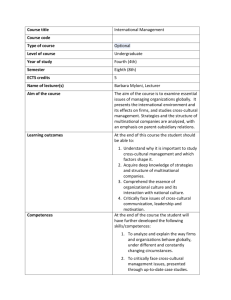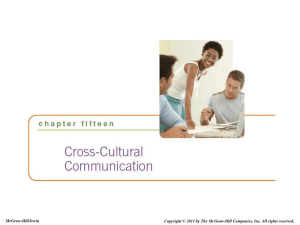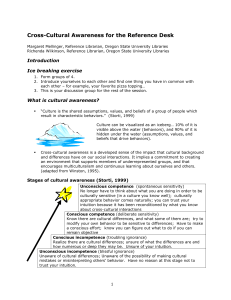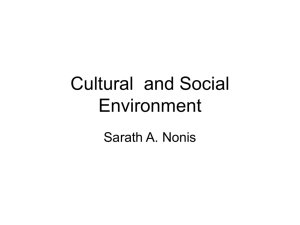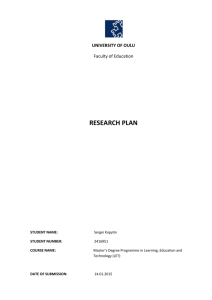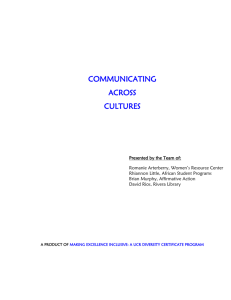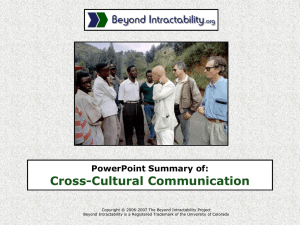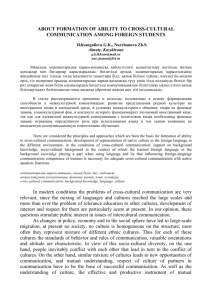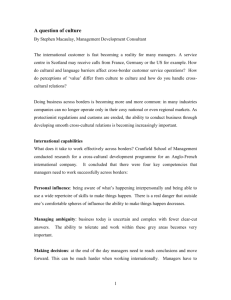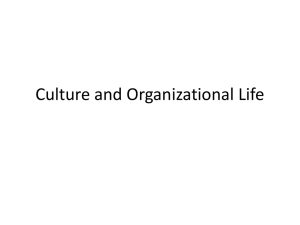PROBLEM OF CROSS-CULTURAL COMMUNICATION IN
advertisement
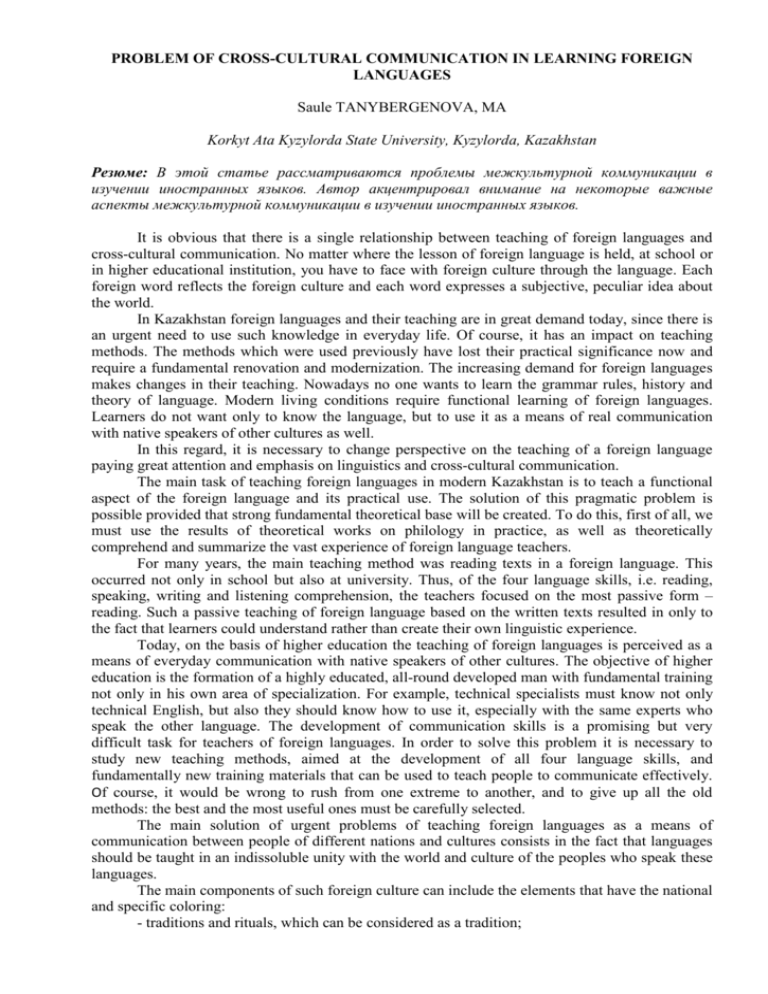
PROBLEM OF CROSS-CULTURAL COMMUNICATION IN LEARNING FOREIGN LANGUAGES Saule TANYBERGENOVA, MA Korkyt Ata Kyzylorda State University, Kyzylorda, Kazakhstan Резюме: В этой статье рассматриваются проблемы межкультурной коммуникации в изучении иностранных языков. Автор акцентрировал внимание на некоторые важные аспекты межкультурной коммуникации в изучении иностранных языков. It is obvious that there is a single relationship between teaching of foreign languages and cross-cultural communication. No matter where the lesson of foreign language is held, at school or in higher educational institution, you have to face with foreign culture through the language. Each foreign word reflects the foreign culture and each word expresses a subjective, peculiar idea about the world. In Kazakhstan foreign languages and their teaching are in great demand today, since there is an urgent need to use such knowledge in everyday life. Of course, it has an impact on teaching methods. The methods which were used previously have lost their practical significance now and require a fundamental renovation and modernization. The increasing demand for foreign languages makes changes in their teaching. Nowadays no one wants to learn the grammar rules, history and theory of language. Modern living conditions require functional learning of foreign languages. Learners do not want only to know the language, but to use it as a means of real communication with native speakers of other cultures as well. In this regard, it is necessary to change perspective on the teaching of a foreign language paying great attention and emphasis on linguistics and cross-cultural communication. The main task of teaching foreign languages in modern Kazakhstan is to teach a functional aspect of the foreign language and its practical use. The solution of this pragmatic problem is possible provided that strong fundamental theoretical base will be created. To do this, first of all, we must use the results of theoretical works on philology in practice, as well as theoretically comprehend and summarize the vast experience of foreign language teachers. For many years, the main teaching method was reading texts in a foreign language. This occurred not only in school but also at university. Thus, of the four language skills, i.e. reading, speaking, writing and listening comprehension, the teachers focused on the most passive form – reading. Such a passive teaching of foreign language based on the written texts resulted in only to the fact that learners could understand rather than create their own linguistic experience. Today, on the basis of higher education the teaching of foreign languages is perceived as a means of everyday communication with native speakers of other cultures. The objective of higher education is the formation of a highly educated, all-round developed man with fundamental training not only in his own area of specialization. For example, technical specialists must know not only technical English, but also they should know how to use it, especially with the same experts who speak the other language. The development of communication skills is a promising but very difficult task for teachers of foreign languages. In order to solve this problem it is necessary to study new teaching methods, aimed at the development of all four language skills, and fundamentally new training materials that can be used to teach people to communicate effectively. Of course, it would be wrong to rush from one extreme to another, and to give up all the old methods: the best and the most useful ones must be carefully selected. The main solution of urgent problems of teaching foreign languages as a means of communication between people of different nations and cultures consists in the fact that languages should be taught in an indissoluble unity with the world and culture of the peoples who speak these languages. The main components of such foreign culture can include the elements that have the national and specific coloring: - traditions and rituals, which can be considered as a tradition; - traditional and everyday culture; - everyday behavior; - national picture of the world that reflects the specific perception of the world; - art culture, which can also be referred as the elements of ethnography and ethnology. As it was mentioned above, the knowledge of the word meaning and grammatical rules is not quite enough to assume that you know language. It is necessary to study the culture of the target language as much as possible. In other words, the theoretical knowledge of the language should be supplemented by practical skills, i.e. you must know when you should say, what to say, whom you should say, as well as how you can use the meaning of a given word in a particular context. That is why more and more attention is paid to the study of the world of language, i.e. the study of the country where the target foreign language is spoken (Vyborova G.E., Melchina O.P., 1998). The students can study communication more constructively if they keep in mind assumptions as follows: - Each person uses communication to reduce uncertainty. People communicate to learn what they need and want to know to cope with their physical and social reality of this or that culture. They tune into the news to get the weather report. They ask questions and share comments to learn how to be social, to know what to say and when, to learn whether they fit in, and to know the basis of the business in which they work. The knowledge of communication rules helps people to adapt to their social and physical realities and to other cultures; - Through communication people create and manage social knowledge, a view of reality that reflects beliefs unique to each group. By sharing meaning with one another, humans can live together with a degree of organization, coordination and predictability; - As people are symbol users, they communicate to get pleasure from the act of communicating. As you think about why you like to entertain and be entertained through communication, you may realize that entertainment also helps us to reduce uncertainty. - Since communication is inherent in the nature of the human being, considerations of ethics must be central to the study of communication (Abdygapparova S.K., 2002) Cross-cultural communication refers to the process of symbolic interaction involving individuals from groups who possessed, recognized cultural differences in perception and behavior that will significantly affect the manner, the form and the outcome of the communication. Cross-cultural communication includes several components: 1. Communicative codes – verbal code (language), nonverbal code (mimics, movements, eye contact, etc.) 2. Worldview is considered to be one of the most important cognitive mechanisms that impact on communication. Worldview is the representation of the internal view of an individual or a group which is organized according to cultural conceptions, reflecting basic values, beliefs and attitudes. 3. Role relationship provides insights into the ways a culture maintains social order and control among its members. Role relationships are organized according to age, gender, social status, power, wealth, knowledge and experience. 4. Thought patterning refers to the processing of data from impressions and experiences in one’s everyday life. It involves encoding and decoding information or reasoning. Thought patterning indicates how individuals form fundamental concepts, organized ideas and defines sources of knowledge. 5. Context can be divided into high (eastern countries) and low (western countries). The study of cross-cultural communication should enhance your understanding of your own culture in relation to other cultures. As a result you should be able to conceptualize areas of potential misunderstanding and be better prepared to act when it occurs. You should be able to convey respect for the way others behave and act positively towards actions that are dissimilar from yours and when you are abroad you ought to recognize the communication variations across cultures and respect value to the host nations. Keywords: cross-cultural communication, foreign culture, real communication, native speakers, linguistic experience, cultural concepts, cultural differences. References 1. Abdygapparova S.K. Practical work in cross-cultural communication. Almaty, 2002 2. Vyborova G.E., Melchina O.P. 70 English topics (I and II levels). M.: AST-Press, 1998 3. Sue O’Conell English for advanced learning. Edinburgh, 1999

